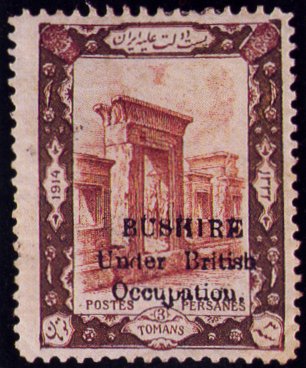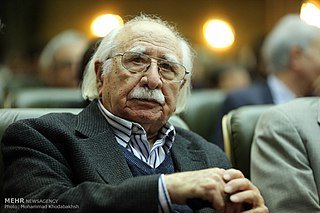
Mahdism in the Twelver branch of Shia Islam, derived from the belief in the reappearance of the Twelfth Shiite Imam, Muhammad al-Mahdi, as the savior of the apocalypse for the salvation of human beings and the establishment of peace and justice. Mahdism is a kind of messianism. From this perspective, it is believed that Jesus Christ and Khidr are still alive and will emerge with Muhammad al-Mahdi in order to fulfil their mission of bringing peace and justice to the world.

Tonekabon, also Romanized as Tonekābon; formerly known as Shahsavar (شَهسَوار), also Romanized as Shahsavār and Shahsawār, is a city in the Central District of Tonekabon County, Mazandaran province, Iran, serving as capital of both the county and the district. The languages of Tonekabon are Mazandarani and Gilaki.

The Anglo-Persian War or the Anglo-Iranian War lasted between 1 November 1856 and 4 April 1857, and was fought between the United Kingdom and Iran, which was ruled by the Qajar dynasty. The war had the British oppose an attempt by Iran to press its claim on the city of Herat. Though Herat had been part of Iran under the Qajar dynasty when the war broke out, it had declared itself independent under its own rebellious emir and placed itself under the protection of the British in India and in alliance with the Emirate of Kabul, the predecessor of the modern state of Afghanistan. The British campaign was successfully conducted under the leadership of Major General Sir James Outram in two theatres: on the southern coast of Persia near Bushehr and in southern Mesopotamia.

Bushehr or Bushire is a city on the southwestern coast of Iran, on the Persian Gulf. It is the chief seaport of the country and the administrative centre of Bushehr Province.

Rais-Ali Delvari was an Iranian military leader. He is remembered as a national hero in Iran who organized popular resistance against British forces after the invasion of Iran in 1915.

Ahmad Khan Daryabeigi was an Iranian military officer and educator.
23 Ramadan is the twenty-third day of the ninth month (Ramadan) of the Islamic calendar.

Ardeshir Reporter or Sir Ardeshir Ji Reporter (1865–1932) a son to Edulji Reporter was born in a Zoroastrian Parsee family in Bombay on 22 August 1865. He was a secret British Intelligence agent in Iran for many years. In fact, he lived and worked in Iran as a secret British Intelligence agent since 1893. He came to Iran under the cover of Times' reporter. It was he who introduced General Ironside to Reza Khan, and it was Ironside who encouraged Reza Khan to seize power. According to his own will, he was the one, who discovered Reza Khan and guided him in the coup on 22 February 1921. Therefore he was instrumental in Reza Khan's 1921 military coup and the consequent establishment of the Pahlavi dynasty and enthronement of Reza Shah in Iran in 1925. Ardeshir Reporter died in Tehran in 1933. His son, Shapoor Reporter, was also a secret agent of the British Intelligence Service in Iran who served the Pahlavi family after Reza Shah's death.
Sallar Deylami is one of the first Iranian Shia jurists during the fifth century of the Islamic calendar. He is considered a jurist of the class of Shaykh Tusi.
Abdolmohammad Ayati was an Iranian author, translator and researcher in the field of philosophy, history and Persian and Arabic literature. He was born on 5 May 1926 in Borujerd, Borujerd County, Lorestan Province, Iran and died on 11 September 2013 in Tehran, Iran. He was selected at the second Iran's Book of the Year Awards for Arabic to Persian translation of the book History of Arabic Language Literature.

The Iranology Foundation is a scientific and research institute in Iran and Iranian studies is the main field of its activities. The Foundation's studies and researches are all topics and issues related to various manifestations of Iranian culture and civilization. The institute was established in 1997 under the supervision of the Presidential Administration of Iran.

Fathollah Mojtabaei is an Iranian author and historian. He is a permanent member of Academy of Persian Language and Literature and a member of the faculty of the Center for the Great Islamic Encyclopedia.

Bibliography of Rasul Jafarian is a list of books published by Rasul Jafarian, cleric, translator, writer and researcher of Iranian history.
The Political History of Islam is a two-volume book by Rasul Jafarian. The first volume is entitled "The life conduct of the Prophet " in 692 pages and the second volume is entitled "History of the Caliphs" in 828 pages. The book has been translated into English, Arabic and Urdu.

Zahabiya Sufism is a Shiite order. The history of dervishes from this order dates to the third century AH and Ma'ruf al-Karkhi. Some believe that the order originated during the ninth century AH in Iran; it first became popular in Khorasan and then in Shiraz during the early Safavid period.
The history of the parliament in Iran refers to the history of this legislative body in Iran, which has gone through various stages. This legislative body has been changing and expanding from a 25-member House of Expediency to the present day, which operates under the name of the Islamic Consultative Assembly with 290 members.

The United States Cultural Diplomacy in Iran refers to the use of soft power of cultural diplomacy by the US government towards Iran in order to achieve its own interests.
The Encyclopaedia Islamica Foundation (Bonyād-e Dāyerat-al-ma̒āref-e eslāmi ) is a public and non-governmental institution that was established in Tehran in 1983-1984 to undertake preparing and publishing Encyclopaedia of the world of Islam to deal issues related to Islam and the history, civilization and culture of Muslim countries, especially Iran, and in this way to consolidate and expand the ties and cultural relations of the Muslim people. It was established by the decision of Ali Khamenei during his presidency. The EncyclopaediaIslamica Foundation has published more than 75 books in Persian and English languages in addition to publishing 29 volumes of Encyclopaedia of the world of Islam and 12 volumes of its translation into Arabic under the title of دائرة معارف العالم الإسلاميّ. These activities take place in the structure of a research institute with more than 120 faculty members and a research library.
House with Open Door is a book by Kameel Ahmady that examines the social phenomenon of cohabitation, called "white marriage" in Iran, in which couples live together without legally marrying.
Mir Seyyed Mohammad Behbahani was one of the prominent religious authorities in Tehran during the contemporary era, playing roles in the Constitutional Revolution and later in the overthrow of Mohammad Mossadegh's government.














